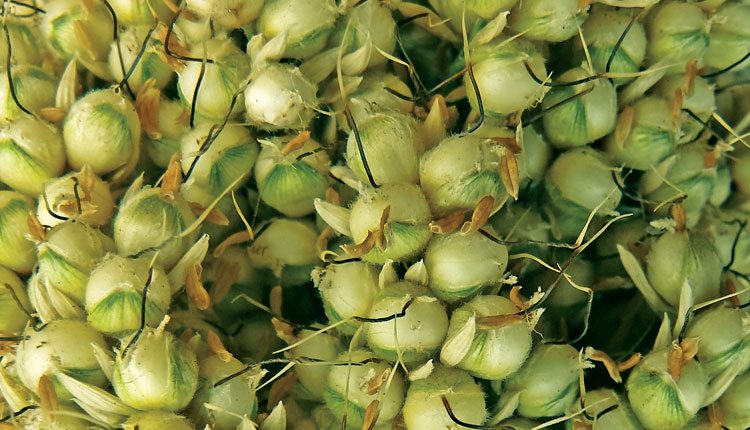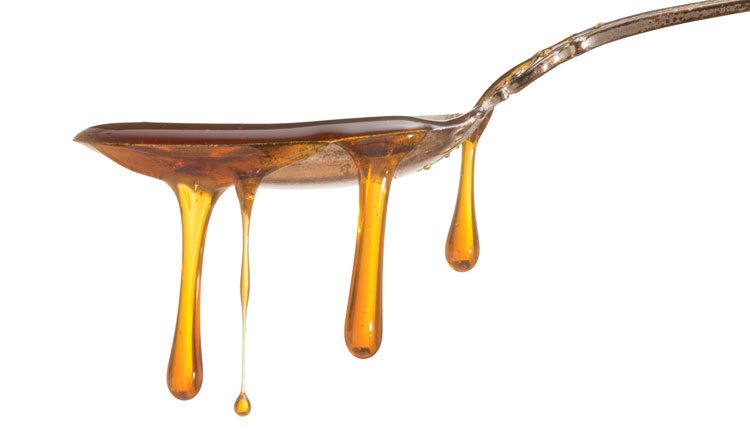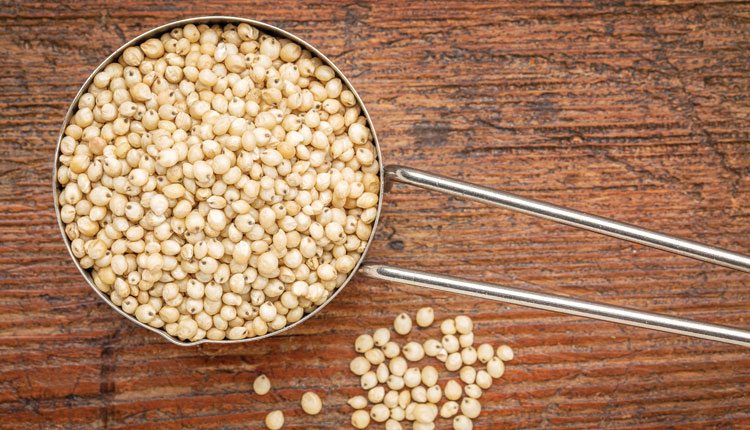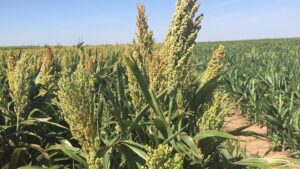In the United States and around the globe, sorghum has become a viable option in the consumer food, pet food, livestock feed and ethanol markets.
Although sorghum is considered an ancient crop domesticated in Africa thousands of years ago, this grain continues to forge ahead in the new millennium. Sorghum’s tenacity to remain a staple crop around the world is largely thanks to its hardiness, market versatility and high-quality seed.
From 1996 to 2011, the number of U.S. acres planted with sorghum was on the decline, bottoming out at 4 million acres. As the Great Plains faced severe drought conditions, more and more farmers returned to planting sorghum as part of their crop mix. In 2015, U.S. growers planted approximately 8.5 million acres. The Top 5 sorghum-producing states in 2015 were: Kansas, Texas, Arkansas, Oklahoma and Colorado.
“Sorghum provides growers with an alternative crop to grow on marginal or arid land,” says Chad Hayes, a sorghum breeder and researcher with the U.S. Department of Agriculture’s Agricultural Research Service. “Since sorghum requires less water than many other crops, it has become a good choice for growers in drought-prone regions in North America, and is also another option to rotate into the crop mix.
“Compared to corn and soybeans, sorghum uses half the water other crops require during a growing season, so drought and temperature stress research is very important.”
Sorghum is naturally drought tolerant, and Hayes’ research efforts focus on increasing this quality through traditional breeding and traditional crosses using USDA’s sorghum germplasm bank, which contains more than 40,000 different types of sorghum.
Because of its natural hardiness, sorghum grows throughout the world in wide-ranging environments. This high level of variety provides a broad genetic base for researchers to work from.
“We can look for DNA markers for specific traits within the sorghum species then apply those to breeding and seed development programs without having to borrow them from other plant species,” Hayes explains.
This means breeders haven’t had to look outside the sorghum species to help improve the crop, so it’s a non-GMO crop. This fact alone makes it popular with consumers, and the health food market is increasingly exploring how they can incorporate this grain into their ingredient lineup.
Find It In the Health Food Aisle
According to William Rooney, professor of sorghum breeding and genetics at Texas A&M University’s College of Agriculture and Life Sciences, consumer perception is changing, particularly in the food and ingredient markets.
“For a long time, the high qualities of sorghum have been overlooked, but this is changing — and rapidly,” Rooney says. “Consumers and buyers today are seeing sorghum as a healthy food with many benefits.”
The consumer food market, a relatively new area of sorghum expansion, is taking this crop to new heights, not only for its many nutritious qualities, but also its genetic qualities.
“We now have important buzzwords out there promoting the high qualities of sorghum such as antioxidants, protein packed, lower fat, high fiber and gluten-free,” says Tim Lust, CEO of the National Sorghum Producers and the United Sorghum Checkoff Program. “Sorghum is a natural, healthy grain being used more and more in our diets as consumer trends evolve.”
Doug Bice, the United Sorghum Checkoff Program’s market development director, shares that sorghum is being used in flour applications due to its gluten-free qualities for those dealing with celiac disease.
“It’s used in various applications,” he says, pointing to syrup and molasses, which come from the stalk of sweet sorghum. The grain is also used as a bran and can be popped, like popcorn but smaller.
Sorghum even made its way into Men’s Fitness as the magazine touted its health benefits: “The ancient grain is eaten with its outer layers intact, so it retains most of its nutrients. These waxy outer layers are loaded with compounds called policosanols that may prevent and treat cardiovascular disease, according to research. Sorghum is also high in antioxidants believed to reduce the risk of cancer, diabetes and some neurological diseases. Its mild, sometimes sweet flavor makes it an easy sub-in for dishes, and its low glycemic index helps keep you full.”
One company that is taking advantage of this whole grain is KIND LLC, which promotes a healthy lifestyle.
“There is currently a big movement in the snack industry to produce kid-related snack food items with healthier qualities,” Bice says. “Sorghum, combined with other ingredients, can form a nutritious snack for children and adults, alike.”
Sorghum’s use isn’t limited for human nutrition; it’s long been used as a livestock feed and more recently picked up steam in the pet food market.
Nutrition for Animals
During the past decade, the pet food market has taken to sorghum for its nutritional benefits and helped to further sorghum research.
Greg Aldrich, a researcher in the Department of Grain Science and Industry at Kansas State University, says that sorghum is a superfood in modern pet food. It is rich in antioxidants, has a low glycemic index, is gluten free, non-GMO and has measurable dietary fiber, he shares. Sorghum also has quality proteins when complemented with sources rich in lysine and processes well into pet food applications.
In addition, sorghum offers better digestibility and fiber for pets, such as cats and dogs, and helps animals maintain a good blood sugar balance, Bice adds.
Although this niche market is relatively small compared to larger livestock markets, sorghum provides a cost competitive and nutritious feed ingredient for pet food companies who are using the grain for carbohydrate blends in dog and cat foods.
According to the Sorghum Checkoff, sorghum is now used by more than 10 pet food companies in more than 135 products. “These companies have helped pave the way in terms of research to discover further uses of this whole grain,” says Lust.
Investing in Research
The pick up in these new markets didn’t happen overnight.
Established in 2008, the Sorghum Checkoff has played an instrumental role in consumer perception and in sorghum investment and market expansion domestically and internationally.
“The purpose of the checkoff is to provide future genetic research as well as demand-driven activities,” Lust says. “Utilization is very important, and the checkoff also looks at productivity and demand for new uses of sorghum throughout the world.”
The checkoff also partners with other industry stakeholders, such as food aid organizations, to help provide additional resources for the less fortunate, as well as help to bring sorghum exports into new regions of the world with growing economies and populations.
One example of this is the checkoff program’s work with Kansas State University on a food aid project aimed at developing novel, extruded, high-protein, sorghum-based micronutrient fortified blended foods that can be used for nutritional aid programs. One of the fortified foods is a sorghum and cowpea blend or porridge mix, which is a complete food for infants.
“Sorghum’s role is still being determined within food aid,” Bice explains. “However, many people in developing countries depend on blends such as these.”
Lust says for many years, sorghum was under-represented and relatively unknown, however, consumers and buyers are taking more notice. “In the past several years, there have been a number of investments led by producers and industry to move sorghum forward into new and exciting markets,” he says.
Traditionally, sorghum has been used as livestock feed as well as in the ethanol industry. But Rooney notes its qualities have expanded its marketability into new food and feed sectors. “There are many markets to sell into, especially the feed grain, forage and ethanol markets,” Rooney says. “Having these markets established provides increasing interest by farmers to grow sorghum. This market versatility has helped growers realize the benefits of growing it.”
Future Demand
Since it can be used as a grain, forage or sugar crop, sorghum is a high energy, drought-tolerant option for growers. Industry experts anticipate the 2016 crop planting to be somewhere between 7 million and 8 million acres. And both the consumer food and pet food industries are now using this grain more and more each year.
While sorghum is used in many different applications throughout the world, there is still room to grow. “Sorghum is an ancient grain with a variety of attributes that are still being determined,” says Bice. “With continued research and development, we can unlock the potential that sorghum has. We have nowhere to go but up in terms of acreage and exports — it’s exciting times.”
Lust adds that it normally takes up to 10 years to get a new product to farmers’ fields. “We are excited that due to producer and industry investments, these high-quality genetics are now coming to market, which will only increase sorghum’s viability and adaptability today and into the future,” he says.
Demand for sorghum remains strong not only in the United States but worldwide. “Many regions are looking at the attributes of sorghum, and how it fits into today’s world,” Lust says.
Maintaining export interest and developing new applications are key to growing the sorghum market.














